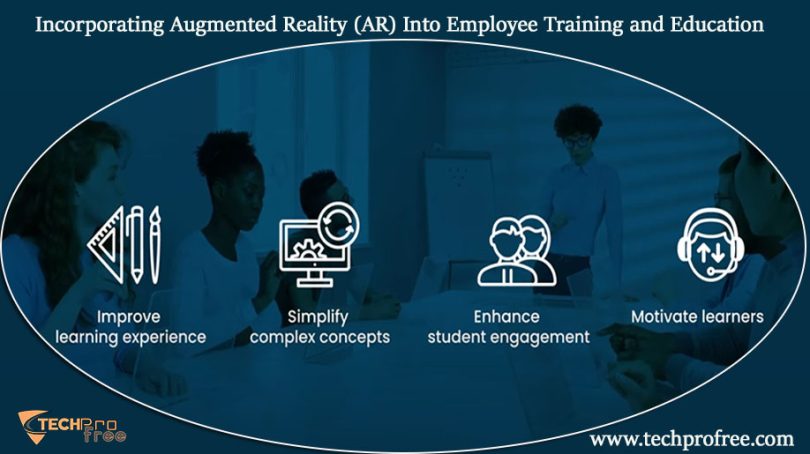The integration of augmented reality (AR) into employee training and education is a result of technological advancements that have introduced various beneficial tools to the workplace. AR, among these technologies, holds immense potential due to its ability to modify and enhance the real-world environment.
By blending virtual elements with reality, AR offers a unique training experience with three key features: the real-time combination of virtual and real worlds, accurate three-dimensional registration, and utilization of readily available hardware.
The Advantages of AR Training: Boosting Learning, Engagement and Efficiency.
AR training provides numerous advantages for both trainees and experienced workers. It enhances learning and comprehension, increases employee engagement, promotes safety awareness, reduces training costs and minimizes learning curves.
Enhancing Engagement and Safety:
Engagement is amplified through AR’s interactive and hands-on approach, enabling trainees to practice job activities at their own pace without external pressures. Safety concerns are addressed as new employees can train for hazardous tasks without risking injury. Moreover, AR training equipment, often accessible through personal devices like smartphones, eliminates the need for expensive seminars or classes.
Overcoming Cognitive Barriers:
AR training overcomes cognitive barriers by offering trainees a comprehensive understanding of job requirements and potential challenges. This immersive learning experience helps individuals grasp concepts more effectively.
Additionally, AR offers several other benefits, that are…
- Motivates trainees to explore the job and company further, thanks to its imaginative and exciting nature.
- Provides more training opportunities, even for experienced workers, with on-demand availability.
- Improves information retention and skill development among trainees.
- Reduces dependency on personnel, allowing them to focus on their primary tasks.
- It is important to note that the benefits of AR in training extend beyond those mentioned above, making it a valuable tool for organizations seeking to enhance their training and education programs.
Implementation of AR Training:
Various industries have already embraced augmented reality (AR) in their training practices. The retail sector, for instance, utilizes AR to simulate complex customer interactions. However, the true potential of AR technology is showcased in fields such as medicine, aerospace, manufacturing, retail and the military.
AR Revolutionizes Medical Education: Empowering Students with Virtual Hands-on Experience.
AR overcomes the challenge of obtaining hands-on experience in medical procedures without actual risk. Medical students can learn about anatomy and practice surgeries using AR, with apps and holograms providing mirrored representations of the human body.
Elevating Aerospace Training and Exploration: AR’s Virtual Guidance and Mars Simulation Capabilities.
In the aerospace industry, AR enables the overlay of virtual parts onto real models and facilitates access to intricate instructions. By reconstructing Mars’ landscape through an app, scientists can prepare for future expeditions from their offices.
Empowering Manufacturing Industry: AR’s Seamless Integration of Theory and Practice.
AR greatly benefits the manufacturing industry by expediting the transition from theory to practice. Headsets provide real-time instructions, allowing trainers to offer feedback during training sessions. This technology proves particularly valuable for welders, enabling faster learning and frequent practice. Manufacturing AR tools utilize voice commands, images, videos, and even enable collaboration through AR glasses.
Transforming Retail Training: AR’s Dynamic Approach for Product Knowledge and Onboarding Success.
Retailers are beginning to adopt AR for training purposes. In addition to situational practice, employees can access product training by scanning items. AR-enhanced onboarding activities, such as virtual tours and team meetings, help new hires familiarize themselves with the company. From sales training to understanding safety procedures, AR facilitates a stress-free introduction to the retail environment.
AR Combat Training: Enhancing Situational Awareness and Tactical Skills for Military Personnel.
The U.S. military employs AR combat training to simulate scenarios that require situational and operational awareness. This training assists soldiers in differentiating between friendlies and enemies. AR technology aids in developing skills related to time, space and forces, providing frequent and in-depth training opportunities.
Currently, there are numerous ways to introduce AR into the workplace, particularly for training purposes. This not only simplifies daily operations for businesses but also provides employees with a fresh and engaging approach to training.
In conclusion, while there may be limitations to AR technology, such as the reliance on voice recognition in industrial environments, the potential for AR in training applications is vast. As AR continues to advance, mobile devices and applications incorporating room scanning technology and 3D mapping will further enhance training experiences.




Leave a Comment